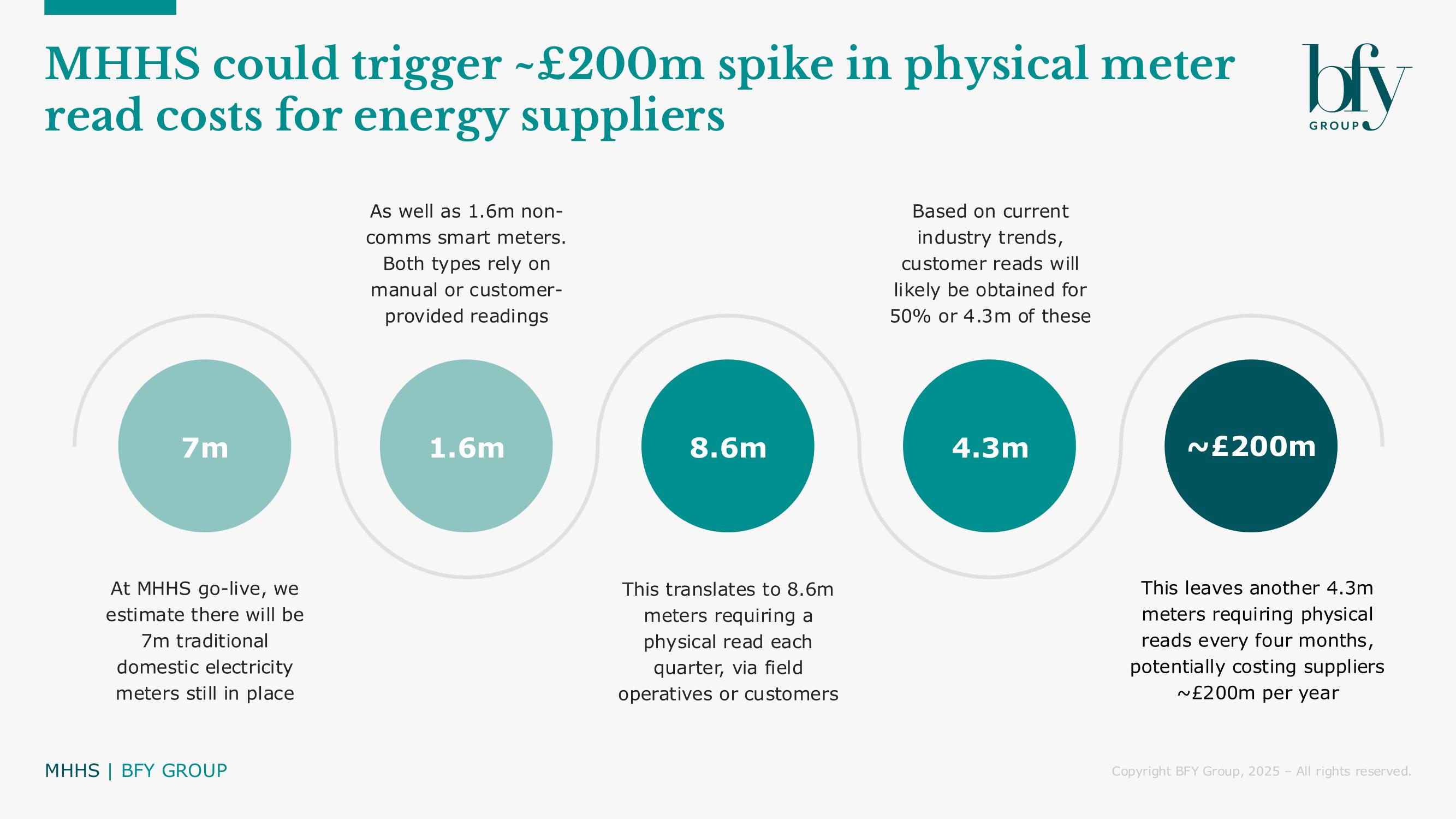With just over half of meters currently operating in smart mode and many suppliers falling short of installation targets, the successful implementation of Market-wide Half-Hourly Settlement (MHHS) faces significant risks.
Instead of reducing costs and reliance on manual processes, MHHS could trigger a significant increase in demand for physical meter reads, undermining market trends from the past 15 years, and the business case for the smart meter rollout. We estimate this spike could cost suppliers ~£200m.
With increased read requirements, a shorter settlement window, and rising operational costs, suppliers should be rethinking their approach to meter read management. On top of this, Ofgem is considering a review of back-bill rules that could shorten the window for backdated billing to as little as 3–6 months.
MHHS aims to create a more efficient, flexible, and sustainable energy market by enabling accurate half-hourly electricity settlements that reflect actual consumption, supporting the transition to a low-carbon future. Customers with meters in smart mode will gain greater control over their energy usage, allowing them to reduce costs by aligning consumption with cheaper, greener energy. However, the market must make significant progress to ensure these benefits are widely accessible.
Below, we explore the scale of the challenge, asking key questions to mitigate financial and operational risk in this evolving landscape. With the MHHS implementation deadline pushed back to May 2027, suppliers have a crucial opportunity to address these issues and position themselves for success under the new regime.
Over 17m physical reads could still be required per year under MHHS
Historically, the electricity market has worked with a 14-month settlement window, but this will shorten to just four months under MHHS. It means suppliers must acquire and validate meter reads much faster, while maintaining accuracy.
At MHHS go-live, a significant number of traditional meters and non-communicating smart meters will remain in operation, requiring manual or customer-provided readings. While customer-provided readings are expected to cover a portion of these meters, the majority will require regular physical reads and site visits to ensure compliance with the reduced settlement timeframes.
We estimate there’ll be 7m traditional domestic electricity meters still in place, and 1.6m non-comms smart meters across the market when MHHS is implemented. Unlike smart meters capable of automated data transmission, these meters rely on manual or customer-provided readings.
This translates to 8.6m meters requiring a physical read, either by field operatives or via customer-provided data per quarter.
Based on current industry trends, customer reads will likely be obtained for approximately 50% or 4.3m of these. This leaves another 4.3m meters requiring physical reads every four months, costing suppliers ~£200m per year based on our estimations.
Even with process optimisation and strategic improvements, such as targeted scheduling and enhanced route planning, the market will still require 17.2m physical meter reads annually.
Can your current meter read strategy handle this surge in demand?

Key questions for optimising your meter read strategy
How dense is your pedestrian read base?
The density of your pedestrian read base is critical. If your meters are more dispersed geographically, it’ll lead to higher costs and lower success rates due to added complexity with logistics, scheduling, and travel. Understanding the spatial distribution of your meter base will help you plan resource allocation and optimise routes for meter readers – utilising advanced analytics will be key.
What’s your approach to voids, vacants, and hard-to-access properties?
Voids, vacants, and restricted-access properties will increase the challenge of obtaining timely and accurate meter reads. Assessing and categorising these properties will enable you to deploy specialised strategies, such as scheduled access appointments or targeted customer communications (e.g., with landlords, unknown occupiers, or those with known accessibility challenges).
Are your third-party contracts fit for purpose?
Review your contracts with third-party service providers. Do you have agreements that ensure scalability, flexibility, and accountability? These qualities will ensure you’re prepared for challenges such as increased customer bases, regulatory changes, or operational inefficiencies, making your partnership more sustainable and effective over time.
Knowing your partners and their performance capabilities is key to maintaining service levels, while managing costs long term.
What are your new performance benchmarks under MHHS?
The MHHS framework emphasises accuracy and efficiency. Consider what performance metrics (e.g., read success rates, timeliness, customer satisfaction) will define success for you, and how you can create collaborative relationships with service providers to meet these goals, by sharing accountability and encouraging continuous improvement.
How are you incentivising customer-read submissions?
Encouraging customers to submit their own meter reads is a cost-effective solution, but how do you incentivise this behaviour? Consider offering discounts, rewards, or even implementing penalties for non-compliance. Beyond incentives, investing in customer education and user-friendly reporting tools can drive engagement and participation.
What’s the financial impact?
The operational cost landscape is becoming more complex. Increased read requests, lower density bases, and enhanced incentives for customer own reads are all driving costs upward. Compounding these are external pressures, such as changes to the price cap which can impact supplier margins, alongside minimum wage hikes and employer NI contributions.
Addressing this cost is a strategic priority
To mitigate the potential spike in physical read costs, energy suppliers need to focus on two core strategies:
1) Streamlining meter reads:
- Optimise scheduling and route planning using advanced analytics and geographical mapping tools
- Partner with third-party providers who specialise in high-efficiency, large-scale meter reads
- Develop clear strategies for accessing hard-to-reach properties, including enhanced communication processes and appointment scheduling
2) Accelerating smart meter installations:
- Prioritise non-comms smart meters and traditional meters for upgrades to fully communicating smart meters - we shared guidance on this here
- Focus on areas where pedestrian read density is lowest to maximise return on investment
- Collaborate with customers to encourage participation in installation programs through education and incentives
Ofgem has indicated a potential review of back-bill rules, which could shorten timescales for backdated billing to as little as 3–6 months. This adds extra urgency to obtaining accurate, timely meter reads and ensuring they’re promptly reflected in customer bills. Suppliers must remain agile and proactive, focusing on data accuracy and streamlined billing processes to avoid compliance issues and customer dissatisfaction.
As outlined above, the current pace of the smart meter rollout suggests a looming spike in physical meter read demand under MHHS - bringing significant financial and operational challenges.
However, with the MHHS implementation deadline extended, there’s still a window of opportunity. Suppliers that act now, by streamlining meter read processes and accelerating smart installations, will be best positioned to lead when MHHS takes effect.
If you're looking to reduce costs and enhance your meter read strategy ahead of MHHS, contact Jon Vincent.
You can also revisit our previous MHHS insights here.
Jon Vincent
Client Director
Jon helps clients resolve problems with billing, settlements, and customer service.
View Profile

